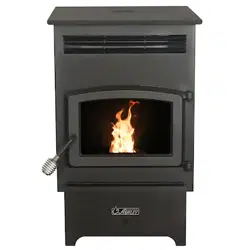Loading ...
Loading ...
Loading ...

16
© 2021 United States Stove Company
NEVER OPERATE THIS PRODUCT WHILE UNATTENDED
CAUTION:
• FAILURE TO CLEAN AND MAINTAIN THIS
UNIT AS INDICATED CAN RESULT IN POOR
PERFORMANCE, SAFETY HAZARDS, FIRE,
AND EVEN DEATH.
• NEVER PERFORM ANY INSPECTIONS,
CLEANING, OR MAINTENANCE ON A HOT
STOVE.
• DISCONNECT THE POWER CORD BEFORE
PERFORMING ANY MAINTENANCE! NOTE:
TURNING THE ON/OFF SWITCH TO ”OFF”
DOES NOT DISCONNECT ALL POWER TO
THE ELECTRICAL COMPONENTS OF THE
STOVE.
• DO NOT OPERATE STOVE WITH BROKEN
GLASS, LEAKAGE OF FLUE GAS MAY RESULT.
• ATTEMPTS TO ACHIEVE HEAT OUTPUT
RATES THAT EXCEED HEATER DESIGN
SPECIFICATIONS CAN RESULT IN
PERMANENT DAMAGE TO THE HEATER.
CREOSOTE FORMATION, INSPECTION,
& REMOVAL
CAUTION:
THE EXHAUST SYSTEM SHOULD BE CHECKED
MONTHLY DURING THE BURNING SEASON FOR
ANY BUILD-UP OF SOOT OR CREOSOTE.
When any wood is burned slowly, it produces tar
and other organic vapors, which combine with
expelled moisture to form creosote. The creosote
vapors condense in the relatively cool chimney
ue or a newly started re or from a slow-burning
re. As a result, creosote residue accumulates
on the ue lining. When ignited, this creosote
makes an extremely hot re, which may damage
the chimney or even destroy the house. Despite
their high efciency, pellet stoves can accumulate
creosote under certain conditions. The chimney
connector and chimney should be inspected by
a qualied person annually or per ton of pellets
to determine if a creosote or y ash build-up has
occurred. If creosote has accumulated, it should
be removed to reduce the risk of a chimney re.
Inspect the system at the stove connection and
at the chimney top. Cooler surfaces tend to build
creosote deposits quicker, so it is important to
check the chimney from the top as well as from the
bottom. The creosote should be removed with a
brush specically designed for the type of chimney
in use. A qualied chimney sweep can perform this
service. It is also recommended that before each
heating season the entire system be professionally
inspected, cleaned and, if necessary, repaired. To
clean the chimney, disconnect the vent from the
stove.
FLY ASH
This accumulates in the horizontal portion of an
exhaust run. Though non-combustible, it may
impede the normal exhaust ow. It should therefore
be periodically removed.
ASH REMOVAL & DISPOSAL
CAUTION:
ALLOW THE STOVE TO COOL BEFORE
PERFORMING ANY MAINTENANCE OR
CLEANING. ASHES MUST BE DISPOSED IN A
METAL CONTAINER WITH A TIGHT FITTING
LID. THE CLOSED CONTAINER OF ASHES
SHOULD BE PLACED ON A NON-COMBUSTIBLE
SURFACE OR ON THE GROUND, WELL AWAY
FROM ALL COMBUSTIBLE MATERIALS,
PENDING FINAL DISPOSAL.
Remove the ashes periodically to avoid unnecessary
ash build up. Remove ashes when unit has cooled.
Ashes should be placed in a metal container with a
tight tting lid. The closed container of ashes should
be placed on a noncombustible oor or on the
ground, well away from all combustible materials,
pending nal disposal. If the ashes are disposed
of by burial in soil or otherwise locally dispersed,
they should be retained in the closed container
until all embers have been thoroughly cooled. The
container shall not be used for other trash or waste
disposal. If combined with combustible substances,
ashes and embers may ignite.
SMOKE & CO MONITORS
Burning wood naturally produces smoke and
carbon monoxide(CO) emissions. CO is a poisonous
gas when exposed to elevated concentrations
MAINTENANCE
Loading ...
Loading ...
Loading ...
